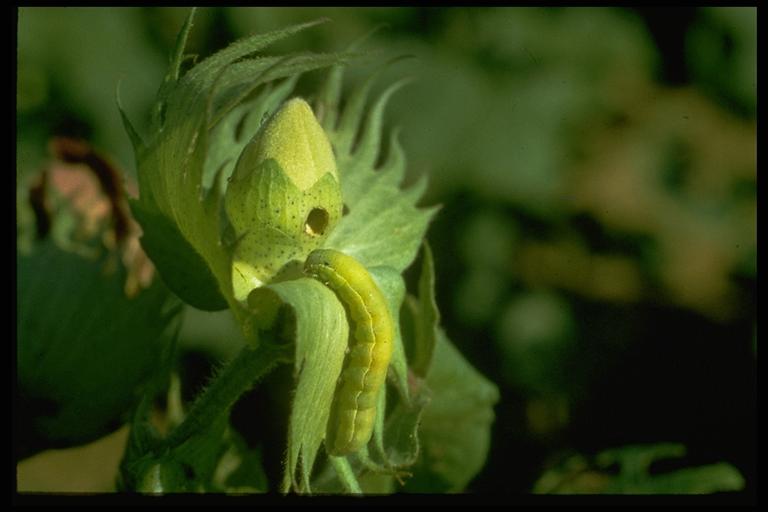
Beet armyworm, Spodoptera exigua (Hübner) (Lepidoptera: Noctuidae), caterpillar in cotton boll. Photo by A. Knutson.
Common Name: Beet armyworm
Scientific Name: Spodoptera exigua (Hübner)
Order: Lepidoptera
Description: The caterpillars (larvae) of the beet armyworm are stages most commonly observed when they can occur in high numbers. Caterpillars are overall green or marked in shades of green with stripes, grows up to about 1 1/4 inches long, and can best be identified by a characteristic small black spot on each side of the second body (thoracic) segment behind the head. Adult moths have a wingspan of 1 to 1 1/4 inches. However, wings are held over the back when at rest The forewings are grayish-brown with two pale spots near the center.
See Fall Armyworm.
Life Cycle: Complete metamorphosis. Winter is usually spent in the pupal stage. In spring, mated female moths (milers) lay clusters of about 80 spherical, ribbed eggs covered with hairs and scales from her body. Tiny caterpillars hatch from the egg mass in 2 to 5 days and develop through five stages (instars) over a period of about 3 weeks. Thereafter, caterpillars pupate in the ground within a cell constructed 1/4 inch deep and made of soil and trash particles glued together with a sticky secretion. Moths emerge within 5 to 8 days. The life cycle requires 30 to 40 days, depending on temperature, and several generations can occur annually. Beet armyworm moths are known to migrate northward each year.
Habitat and Food Source(s): Caterpillars have chewing mouthparts. Adults have siphoning mouths. Young larval stages feed close together, often grazing on the outer (epidermal) layer of cells on the underside of leaves. They may spin a light web over the foliage. Older, larger caterpillars feed alone and consume leaf tissue that can result in complete defoliation of host plants. In cotton fields, they also feed on developing squares and bolls. Alfalfa, citrus, corn, grasses, legumes, onion, ornamental plants, pea, pepper, potato, soybeans, sugar beets, sunflower, tomato, vegetables and weeds such as plantain and pigweed also serve as hosts for this species.
Pest Status: Caterpillars feed on foliage on a wide variety of agronomic and horticultural crops and cause severe crop losses when they occur in large numbers; medically harmless.
For additional information, contact your local Texas A&M AgriLife Extension Service agent or search for other state Extension offices.
Literature: Cameron et al. 1982. Bohmfalk et al. 1982.